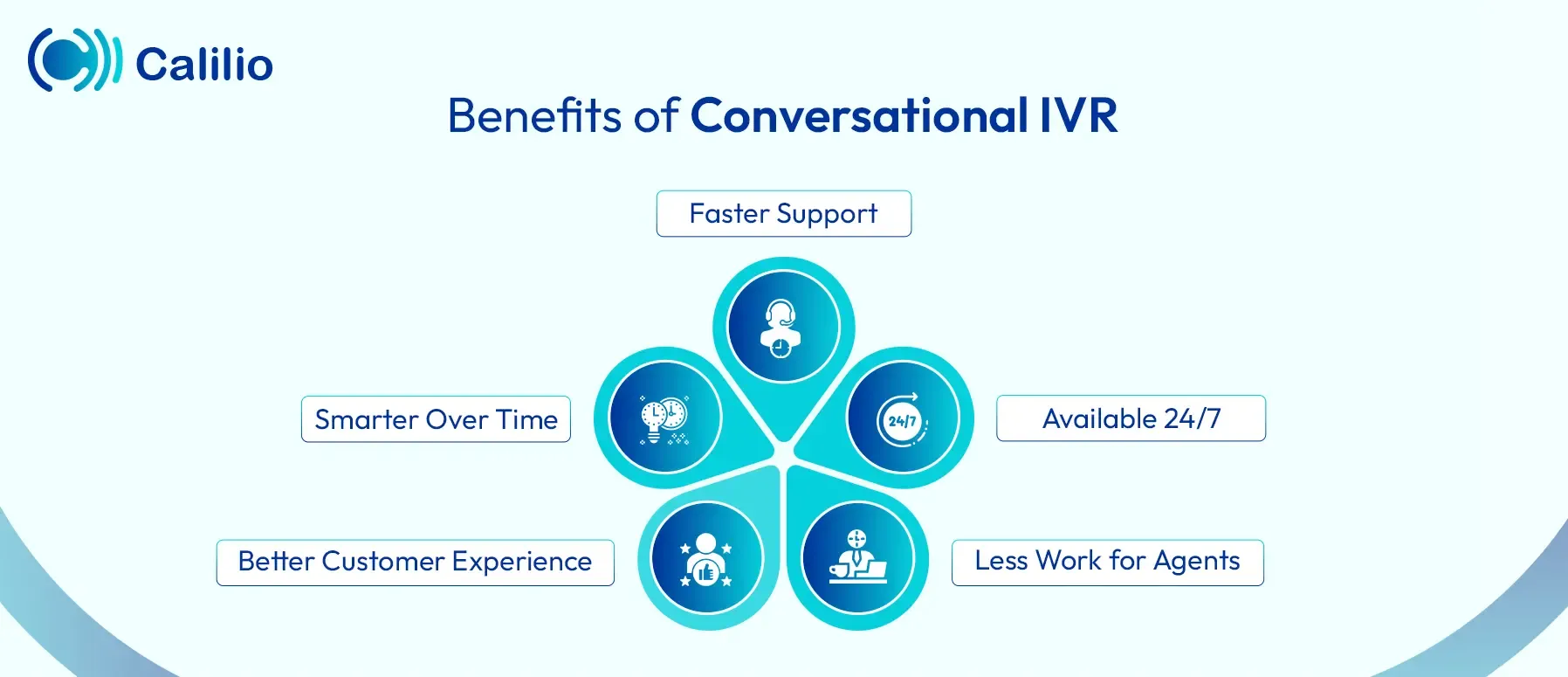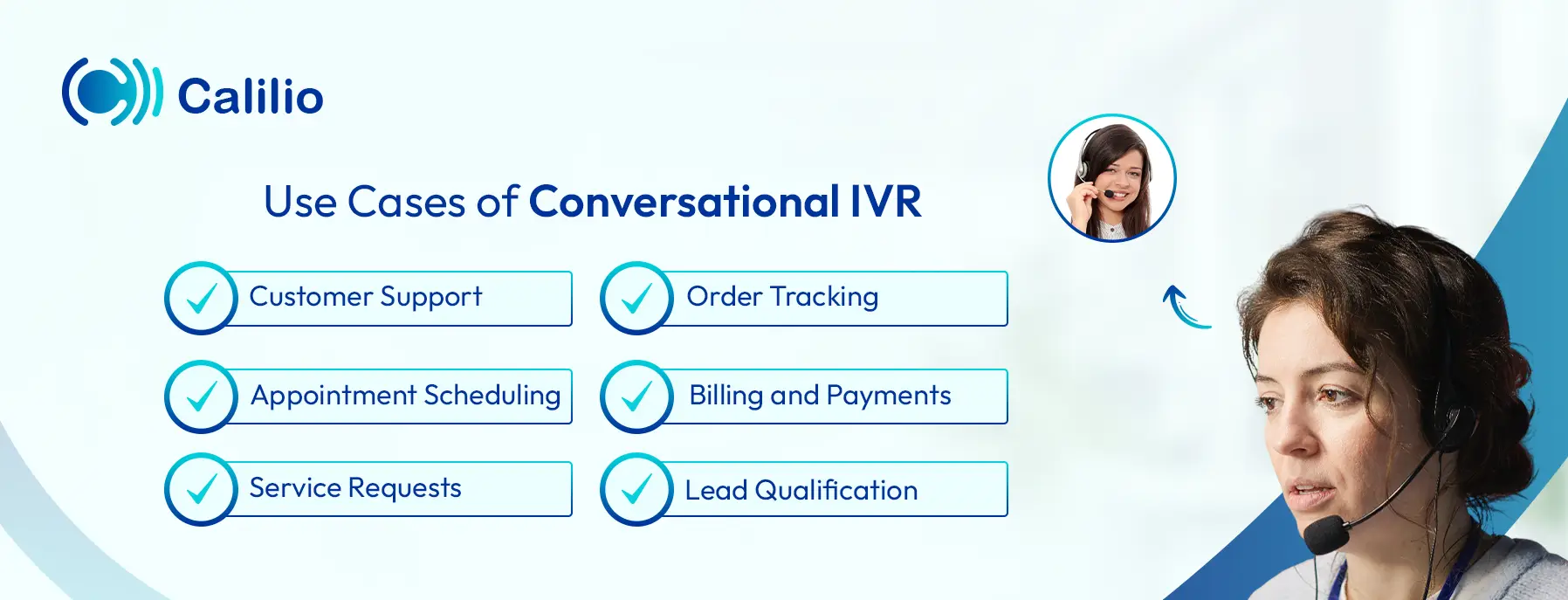What is Conversational IVR? Benefits, Use Cases, & Set Up

Traditional IVR systems often frustrate customers with long, confusing menus and rigid number-based options. This outdated approach often leads to slow resolution and abandoned calls. For businesses, this means lost revenue, lower satisfaction scores, and a weakened brand image.
Conversational IVR changes the game. Powered by AI, it enables customers to speak naturally, just like they would to a live agent. The result? Faster service, reduced wait times, and more satisfied customers.
In this guide, we’ll learn what conversational IVR is, its benefits and use cases, and how it works. We’ll also explore how it differs from a traditional IVR and how to implement it for your business.
What is Conversational IVR?
Conversational IVR is a type of Interactive Voice Response (IVR) that enables customers to communicate using natural speech rather than pressing keypad numbers. It provides a flexible, human-like interaction by automatically understanding spoken requests and resolving issues. If the issue is too complex, it routes calls to the right agent without requiring manual input.
For example, when you call a business, you might say, “I want to check my order. " The system will recognize your request and assist you. It listens and responds in real time, eliminating the need to navigate long menus or wait for a live agent.
How Does Conversational IVR Work?
Conversational AI IVR uses natural language processing (NLP) and machine learning to create seamless, human-like phone interactions. This speech-enabled IVR lets customers speak freely, making interactions faster, more innovative, and more natural.
Let’s look at how conversational IVR works in detail:
- Customers are greeted with a friendly pre-recorded voice.
- Then, Automatic Speech Recognition (ASR) processes your spoken words and converts them into text.
- Next, Natural Language Understanding (NLU) interprets the text to identify speaker intent, for example, whether you’re asking about billing or technical support.
- Based on this, the system’s dialog manager decides the most appropriate next step.
- If the system recognizes your request and has a ready response, it replies using Text-to-Speech (TTS). For more complex queries, it may ask follow-up questions for clarification, such as, “Can you describe the issue you’re having?”
- During the conversation, it can access a knowledge base to retrieve answers to common questions or gather relevant information.
- Based on the conversation, the system routes the call to the right department, offers self-service options, or transfers the caller to a live agent for more complex issues.
Benefits of Conversational IVR
Conversational IVR enhances the customer experience while reducing operational costs. It automates routine inquiries, ensures 24/7 availability, and eases the workload on human agents, helping call centers lower costs without compromising the support quality.

- Speed Up Resolutions: Callers get quick answers or are routed to the correct department without navigating long menus, saving time and reducing frustration.
- Create Human-like Interactions: Conversational IVR allows customers to speak naturally, making interactions feel more human, personal, and less stressful than traditional button-pressing systems.
- Free Up Agent Workload: The system handles simple, repetitive questions, allowing agents to focus on more complex or specialized issues and improving overall efficiency.
- Offer 24/7 Availability: The system operates around the clock, ensuring customers can access support anytime, even outside business hours.
- Get Smarter Over Time: Using machine learning, the system improves with each interaction, becoming more accurate in understanding and handling customer needs.
Conversational IVR vs Traditional IVR
Traditional IVR relies on rigid, menu-based keypad inputs, requiring customers to select options using their phone’s keypad. In contrast, conversational IVR uses natural speech recognition and language understanding, allowing callers to interact freely and naturally with the system.
Feature | Traditional IVR | Conversational IVR |
How it works | You have to press numbers to choose from a fixed list of options. | You can speak naturally and explain exactly what you need. |
User experience | The process can be slow, robotic, and confusing, especially with long menus. | It feels quick, easy, and much more like a human conversation. |
Flexibility | You're limited to a set menu, which can be frustrating when it doesn’t cover your needs. | It understands many different requests, even if they're phrased differently. |
Time Taken | You may spend a lot of time navigating through menus, leading to slower resolution. | You get routed directly to the right solution, saving time and hassle. |
Error handling | It requires exact input, so any mistake can lead to delayed resolution. | It’s smart enough to handle unclear or varied responses, making the process smoother. |
Caller satisfaction | Often lower, due to confusing or long menus. | Much higher, since the system feels more intuitive and user-friendly. |
As the comparison shows, conversational IVR dramatically improves efficiency, flexibility, and satisfaction across the board.
Manage A High Volume of Inbound Calls Conveniently With An Affordable IVR System!
Reduce wait times and connect callers to the right team seamlessly. Elevate your support now.
Use Cases of Conversational IVR
Conversational IVR helps automate tasks such as checking account details, tracking orders, scheduling appointments, handling billing, processing service requests, and qualifying sales leads.

- Customer Support: Conversational IVR is used to handle inquiries, reservations, check account details, route calls, or find basic information based on customer voice prompts.
- Order Tracking: Customers can simply ask, "Where is my order?" and receive instant updates on their order status, without the need to speak with an agent, saving time for both parties.
- Appointment Scheduling: Customers can easily book, reschedule, or cancel appointments by speaking to the system, eliminating the need for long waits or agent involvement.
- Billing and Payments: Callers can check their balances, review due dates, or make payments directly over the phone using voice commands, ensuring a smooth and efficient experience.
- Service Requests: Users can report issues, request services, or ask for assistance without waiting on hold or navigating complex menus, making the process quicker and more convenient.
- Lead Qualification: Sales teams can use conversational IVR to collect basic information from potential customers and immediately route high-priority leads to the right representative for further action.
How to Implement Conversational IVR?
To implement a conversational IVR, define your goals, select the right VoIP provider, design and train the system, and then continuously monitor and improve it.
1. Define Objectives and Use Cases
Start by identifying what you want your Conversational IVR to achieve, whether it's reducing wait times, automating routine inquiries, or improving routing accuracy. Then, define key caller intents such as billing support, appointment booking, order status, or technical assistance to guide the system's design.
2. Choose the Right VoIP Provider
Select a VoIP or contact center provider that offers built-in conversational IVR features. Look for platforms that support natural language input, customizable call flows, and easy integration with your existing tools. Providers like Twilio, RingCentral, Nextiva, NICE CXone, and Sprinklr offer these capabilities.
You can get a new business number (or port your existing one), create team accounts, and configure call routing to start handling calls efficiently.
3. Design Conversation Flows
Replace rigid menus with natural, flexible conversation prompts. For example, instead of saying “Press 1 for support,” use an open-ended prompt like “How can I help you today?” and allow callers to respond naturally with phrases such as “I need help with billing” or “I want to reset my password.”
4. Train and Test the System
Train the IVR with frequently asked questions to improve accuracy. Then, test it using different phrases. If responses are off, retrain the system to ensure smooth, natural interactions.
5. Add Fallbacks and Live Agent Transfers
Always offer callers the option to speak with a live agent. If the system doesn’t understand a query after one or two attempts, it should automatically transfer the caller to a human to prevent frustration and drop-offs. A seamless call transfer to live agents ensures the experience stays smooth, even when AI hits its limits.
6. Monitor and Improve
Launch it for your customers, then monitor performance using call analytics. Key metrics to monitor include call drop rates, first-call resolution, transfer frequency, and customer satisfaction. Refine and retrain the system as needed over time.
Conclusion
Conversational IVR is changing the way businesses manage customer support by replacing outdated keypad-based input with AI-powered, voice-driven interactions. It speeds up resolution, improves satisfaction, and enables customers to speak naturally, thereby reducing the load on customer support agents.
However, if you’re a small business, you may not need a complex, voice-based AI system to deliver excellent support. In such a case, you can simply use a smart IVR from a trusted provider, such as Calilio. Calilio’s IVR system delivers reliable VoIP service, customizable menus, intelligent call routing, and multilingual support, helping your customers connect with the right agents quickly and efficiently.
No Tricks, Just Treats
Use Code CALILIOWEEN25 & Get A Spooktacular 10% Off Your Calilio Subscription. Start Your Savings Now!
Wicked Savings Of 10% Off With Code CALILIOWEEN25
Frightfully Affordable Virtual Numbers From - Just $2/month
The Most Hauntingly Affordable VoIP for Businesses
Powered by AI magic That’ll Cast A Spell On Your Calls


Frequently Asked Questions
How does conversational IVR improve customer service?
Conversational IVR enables callers to express their needs, and the system responds immediately or directs them to the appropriate agent. It speeds up the interaction and finds a resolution faster.
Can small businesses use conversational IVR?
Is conversational IVR the same as a chatbot?

Still have questions?
Can’t find the answer you’re looking for? Please chat with our friendly team.
Stay in the loop
Get the latest call insights, trends, and updates delivered straight to your inbox.
By subscribing, you agree to receive updates from Calilio.
You can unsubscribe anytime.
